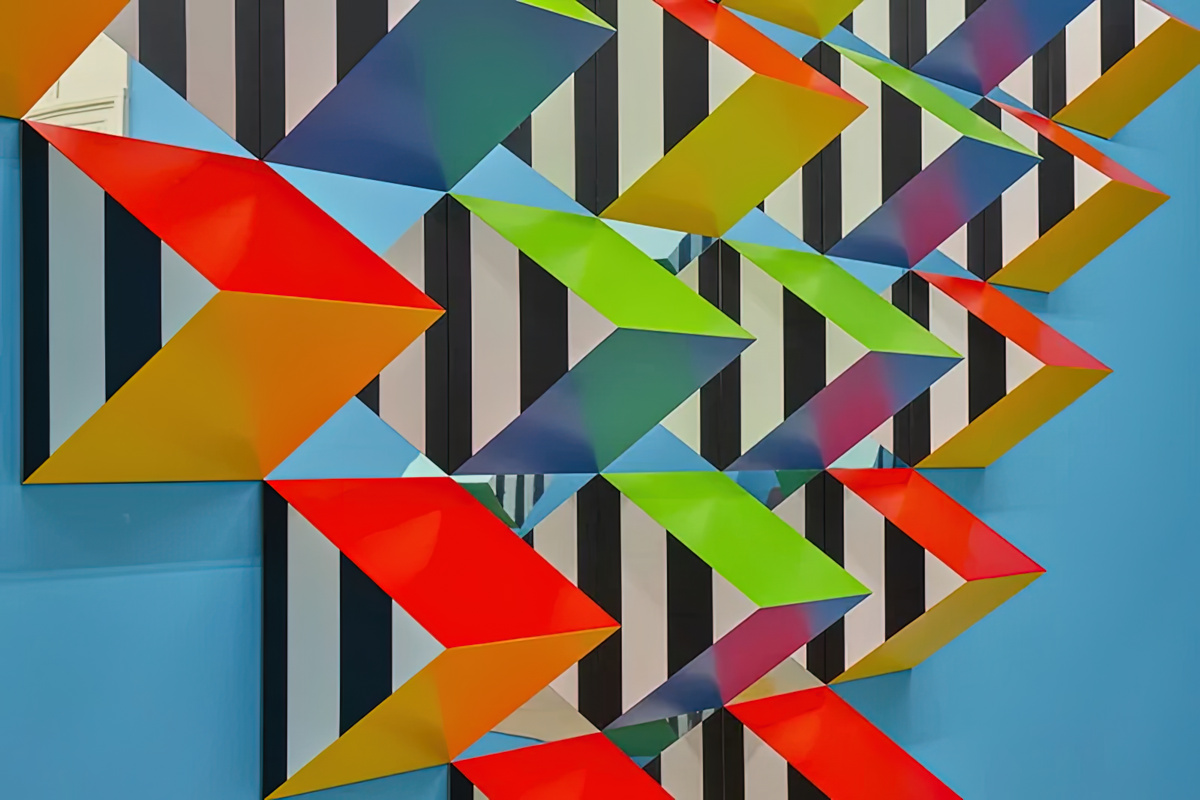ART CITIES: Dubai-Daniel Buren
 Since the 1960s, Daniel Buren’s pioneering Conceptual approach to sculpture and installation has expanded the boundaries of traditional artmaking and complicated the relationship between art object and environment. Buren first rose to prominence as a member of BPMT, a collective named after the last initials of its members: Buren, Olivier Mosset, Michel Parmentier, and Niele Toroni. Their work promoted institutional critique as they tried to rid art of representational obligations and destroy the notion of authorship. Buren has embraced a signature vertical stripe motif and tailor-made, colorful in-situ installations that respond to their environments.
Since the 1960s, Daniel Buren’s pioneering Conceptual approach to sculpture and installation has expanded the boundaries of traditional artmaking and complicated the relationship between art object and environment. Buren first rose to prominence as a member of BPMT, a collective named after the last initials of its members: Buren, Olivier Mosset, Michel Parmentier, and Niele Toroni. Their work promoted institutional critique as they tried to rid art of representational obligations and destroy the notion of authorship. Buren has embraced a signature vertical stripe motif and tailor-made, colorful in-situ installations that respond to their environments.
By Efi Michalarou
Photo: Galleria Continua Archive
On entering Daniel Buren’s solo exhibition “HORIZON, INFINIMENT, travaux in situ et situés”, the visitor is greeted by two series of high reliefs dating from 2019, “Croix” and “Prismes et Miroirs”, which summarize the various branches of research approached by Daniel Buren throughout his career. They also consider space, or rather the environment in which the works unfold. “Croix 1”, a work presented for the first-time during Daniel Buren’s major exhibition at the Museum of Italian Art in Lima, Peru, consists of prisms arranged in the shape of an x-shaped cross, on mirrors that form a large reflective surface. The surfaces of the prisms visible from the front are painted black for the upper part, and orange or green for the lower part. The two lateral sides feature the famous vertical stripes, here in white and black. The discovery by the artist of a striped fabric at the Saint-Pierre market in Paris in 1965 is now part of the history of art. These 8.7cm wide vertical bands, alternately white and colored, have become his “visual tool”, a device for revealing the space in which the works unfold. When looking at the vertical bands that underline a relief, an architectural detail punctuating a place, our eye begins to wander, following the movement into every corner and on every surface. We thus learn to see, to observe the space that surrounds us and in which we find ourselves. “I don’t show stripes, stripes allow me to show things,” says the artist. The reflections created by the mirrors in the high reliefs also allow us to underline another fundamental point of Daniel Buren’s work: the absence of a single point of view. The mobility of the viewer contributes to the creation and constant modification of the work. The work lives with the viewer, and therefore also lives through their movements in the exhibition space. The unique nature of the high reliefs is due to their mobility. Indeed, the artist defines them as “situated works”, which certainly feed on their environment, but can be rethought elsewhere, in other places. This is how they differ from in situ works, which remain inseparable from a space. This notion theorized by Daniel Buren clearly indicates that works in situ must be designed, produced and exhibited, in and for a specific place. It is not possible to move them: the life of the work depends on the space in which, and for which, it was made. This often-ephemeral nature of the in situ works anchors them even more in reality and the present. The work must be seen, felt, experienced before it disappears or is produced again in another form, for another project and in another space. This is why, after having observed each element of the works in turn, the visitor can glimpse a door, an opening towards the back of the gallery which invites them into a distinct space, created especially for the exhibition. Designed with the architecture of the space in mind, the work in situ entirely made of mirrors invites the viewer’s imagination to wander, allowing us to turn on, as the artist says, our “third eye”. It shows what is behind us and what is usually invisible to us. The present moment multiplies and the work reveals a broader vision of a now infinite horizon. Throughout the day, the work and the architecture in which it unfolds, changes and evolves with each ray of sunshine and each effect of light: the symbiosis between the work and its environment is complete.
Photo: Daniel Buren, Pyramidal, haut-relief – A 9 (detail), 2016, Aluminum prisms, acrylic satin paint, aluminum Alucobond panels, 8.7 cm black vinyl stripes, 261 x 478,5 x 30,45 cm © DB-ADAGP Paris. Courtesy of the artist and GALLERIA CONTINUA
Info: Galleria Continua, Burj Al Arab Jumeirah, Umm Suqeim 3, Dubai, UAE, Duration: 3/33-14/5/2023, Days & Hours: Daily 11:00-13:00 & 14:00-20:00 by Registration only (book here), www.galleriacontinua.com/
